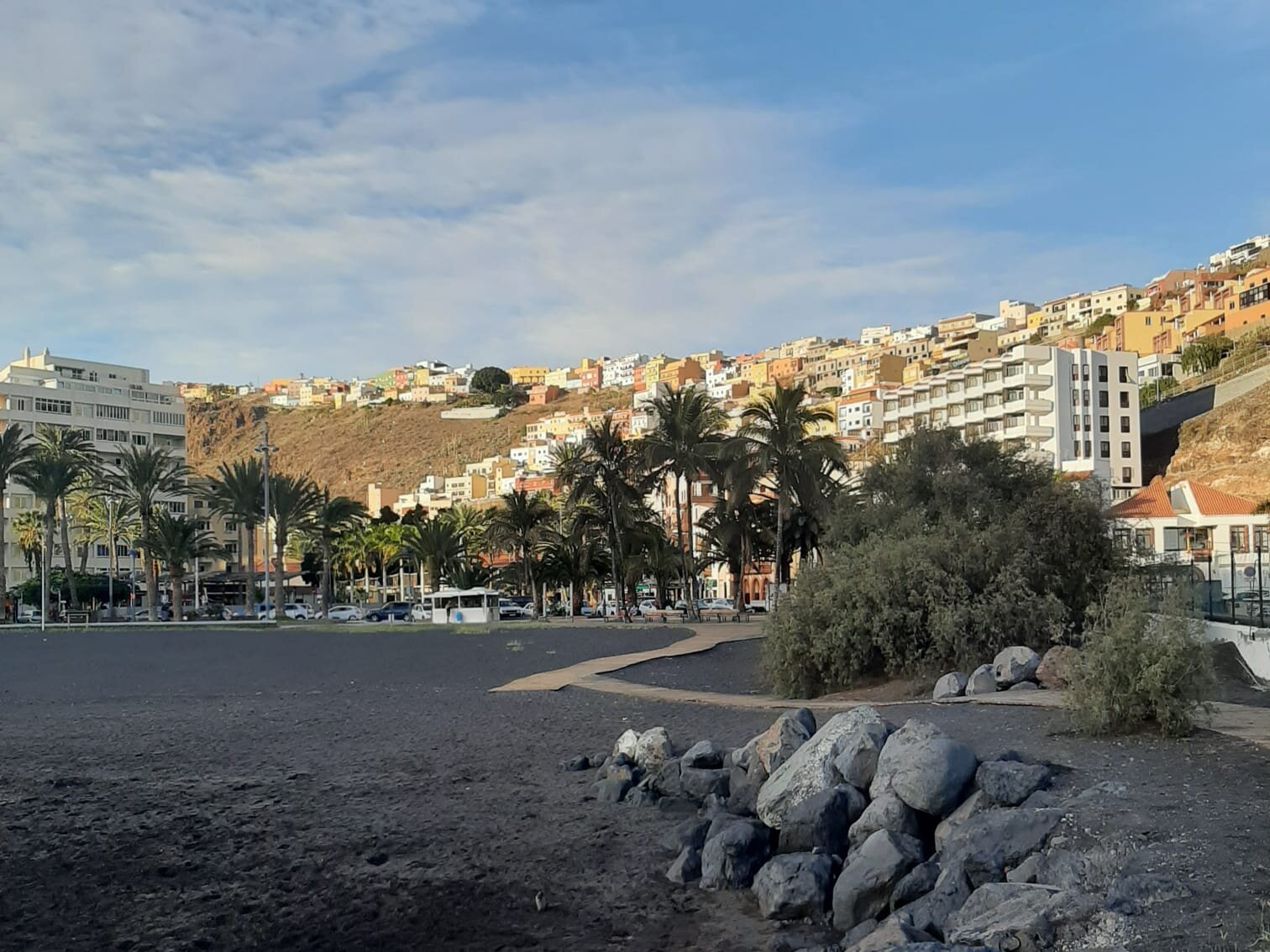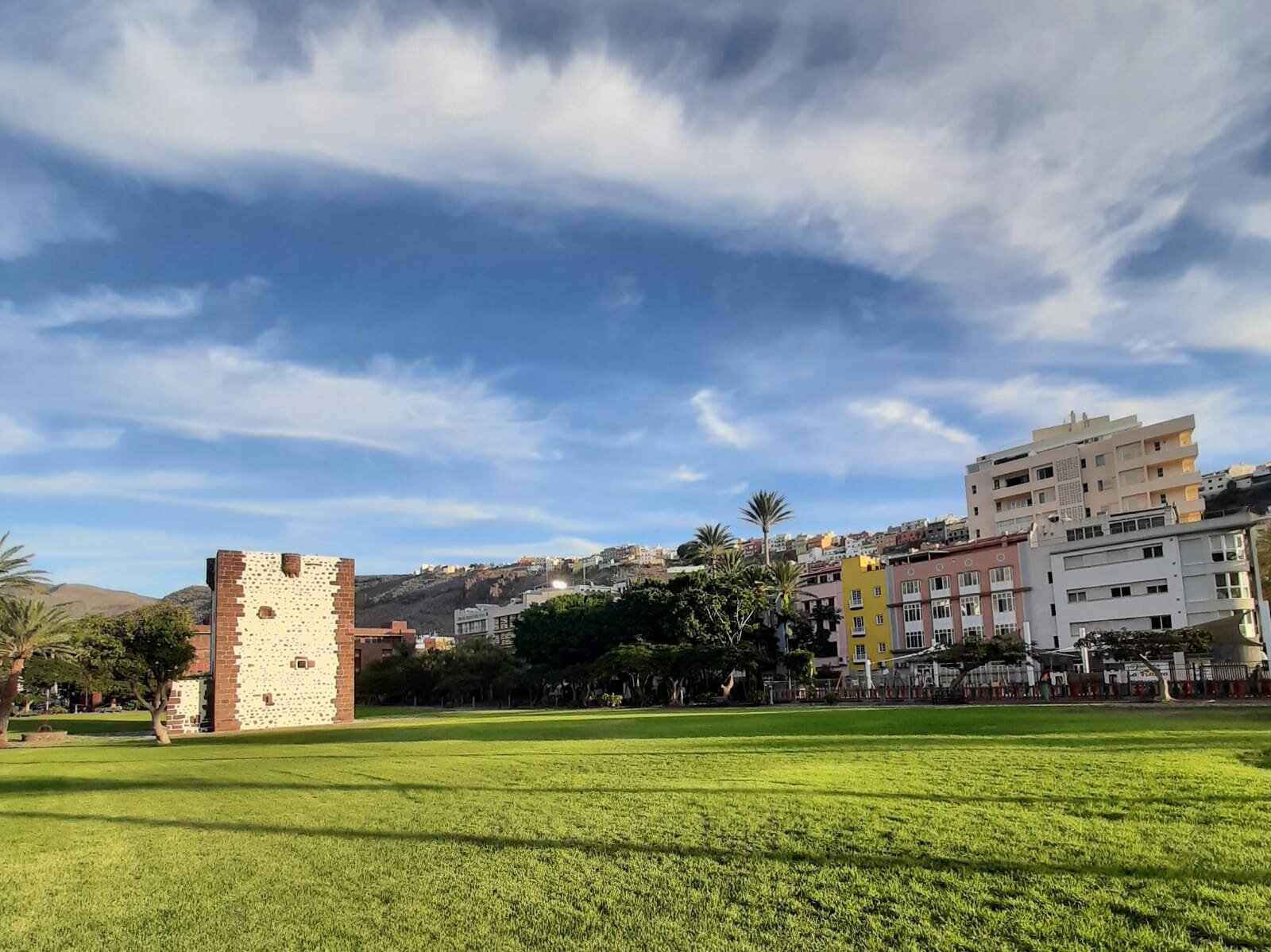Villages of La Gomera
San Sebastian de la Gomera
La Gomera is the second smallest island of the Canary Islands. Officially, about 21,000 people live there, most of whom live in one of the 4 larger and more known places. We were in La Gomera for 6 weeks, enough time to visit these 4 places. Read about San Sebastian, Hermigua, Vallehermoso and Valle Gran Rey in this blog.
About 21,000 people officially live on La Gomera, but we have been told that in reality fewer people actually live there. The official number of registered people may be 21,000 people, but not all of them live there. There are quite a few people who have a house on La Gomera or who are registered but do not live there. Assume less than 20,000 people actually live on the island. That is of course not much for an island with a surface of 370 km2. And that is noticeable. Quite a few people live in the larger villages, you can see and notice that. But the smaller places in the mountains and ravines are really small and remote, with a few hundred people living there or less.
Both these smaller places and the 4 larger places are worth a visit. In this blog we focus on the larger places, also of course because there are nice things to talk about. We start with the capital San Sebastian. Yes capital, but with almost 9,000 inhabitants it is more of a village then a town. But an important village for the island because the largest port is in San Sebastian, making it the largest logistics hub on the island. Every day the ferries from Tenerife and La Palma arrive here and in normal circumstances they carry large groups of people. In addition, a lot of freight transport is done via these ferries. There are also about 100 cruise ships per year that dock in San Sebastian during normal times, often for a day. The tourists who are brought to the island are an important source of income.
Torre del Conde
Torre del Conde is a 15th century fortress in the park in San Sebastian
San Sebastian is located in a beautiful spot on the east coast in a somewhat wider barranco (ravine or valley). This allowed the Guanches, the original inhabitants, to settle here in the past. In 1404 the island was conquered by the Spaniards. Christopher Columbus used La Gomera as his last dock before embarking on his ocean crossing to America in 1492. The house in San Sebastian where he stayed is now a tourist attraction.
In addition to the pleasant harbor where many pleasure boats moor and where a nice little beach is located, San Sebastian also has a small but pleasant center with terraces, shops and restaurants. Especially on sunny days and warm summer evenings it is a great place to be. And if you're strolling through San Sebastian, take a walk through the Parque de la Torre del Conde with the Torre del Conde, a 15th century fortress that was used as a defensive lookout point. On the east side of the park is the center of the village with a number of pleasant streets and shops. A little more to the north of the center is the Archaeological Museum. We have not visited this, we are not lovers of archeology. But for those interested, it seems to be well worth a visit. San Sebastian is a nice small town or large village where you can certainly enjoy yourself for a day.
Hermigua
Hermigua lies in the barranco towards the north with great Atlantic Ocean views
On the north side of the island are Hermigua and Vallehermoso, not that far apart. You can reach Hermigua by taking the GM-1 (island mainroad) from San Sebastian and after a drive through and over the enchanting green barranco's you reach Hermigua after half an hour. It is located in the barranco that runs to the north coast and from most places in Hermigua you have a beautiful view over the Atlantic Ocean and you can often see Tenerife in the distance. Hermigua is not that big and about 2,000 people live there. Hermigua is especially nice to visit because you have a beautiful view of the ocean to the north and to the barranco and the Parque Nacional de Garajonay to the south. And from Hermigua you can take beautiful hikes to the national park. If you continue on the GM-1 you go towards Vallehermoso. But if you take the CV-3 and / or Cv-4 side roads from GM-1 immediately after Hermigua, you are heading east to the northeast coast. These are narrow winding roads to drive but at the end of CV-3 you come to Playa de la Caleta. This is seen as the most beautiful beach in La Gomera. We have been there and the location is indeed great, but it is not a sandy beach, so you have to rely on rocks. For more information about Playa de la Caleta, read our blog about the beaches of La Gomera.
Vallehermoso
Vallehermoso lies in a very green barranco and coming from the east you have stunning views of the village
If you follow the GM-1 road from Hermigua you will arrive in Vallehermoso. The GM-1 stretch between Hermigua and Vallehermoso is a phenomenally beautiful stretch to drive. It is a 20km stretch but it only takes half an hour because the road is very winding and steep in certain places. But that gives you as a passenger (the driver really has to keep his or her eyes on the road) time to enjoy the views around you. After Hermigua the road actually turns along the north coast and sometimes provides great views of the Atlantic Ocean and the barrancos. The closer you get to Vallehermoso, the more beautiful the view becomes. Just before Vallehermoso you turn to the left around the mountain and you really see the village looming like a little devil out of nowhere, lying in the barranco against the mountains. Especially in good weather this gives an enchanting view. Vallehermoso has about 3,000 inhabitants and a small but pleasant center with a square with terraces and a few restaurants. Because we could be in Vallehermoso relatively quickly from our accommodation in Tazo, we came there regularly to do some shopping or to drink a coffee. For our coffee, we always went to the espresso bar Lucia Cosas de Verdad. There they have delicious good coffee and sweet pastries and a nice terrace. In Vallehermoso there are also a few beautiful miradors, viewpoints of which the Mirador de Vallehermoso with beautiful views over the village and the barranco is definitely recommended.
Valle Gran Rey
Valle Gran Rey, the Great King’s Valley, lies at the end of a very deep barranco on the coast
In the southwest lies Valle Gran Rey. It is a municipio (municipality) that actually consists of a number of small villages in the valley and especially on the coast. The name Valle Gran Rey actually says what it stands for. Translated from Spanish it means the Great King’s Valley, and it definitely is. There is only one road to Valle Gran Rey and that is the GM-1, which after Vallehermoso turns south and southwest. After the small village of Arure you drive through two tunnels. Just before the first tunnel you can see Valle Gran Rey and the valley from more than 1000 meters above the barranco, with the villages on the coast in the distance. With good weather it is a beautiful view, but it is often also a bit foggy and cloudy and then the view also has something mysterious. After the second tunnel you drive a few kilometers down a winding road into the valley until you reach the roundabout at the coast. Just before the roundabout is La Calera and if you go to the right you will arrive in Playa de la Calera. It is a cozy little village with shops and a nice little boulevard on the small beach with a beautiful view over the bay. A little further west there is also Playa del Ingles, where nude recreation is allowed.
Valle Gran Rey
There are some lovely beaches in the small villages in Valle Gran Rey
If you turn left from the roundabout and thus to the east, you will successively arrive in the villages of La Puntilla, Borbalan and Vueltas. It is all close together and next to each other in the bay. Between Playa de la Calera and Vueltas there is a long sandy beach (lava) that is really a great beach when the tide is not too high. We spent some wonderful afternoons on this beach. At the end of the bay is Vueltas, which also has a nice small center, a nice harbor and a beach in the bay at the end. One of the great advantages of Valle Gran Rey is that there is a good bakery that has really good bread. The bakery Pan de Vueltas is located in both Playa de la Calera and Vueltas itself and has a German background. Because there are not many places on the rest of the island where you can get really good bread, you are quickly prepared to go to Valle Gran Rey especially for this bakery. Valle Gran Rey is a wonderful place with a number of nice places and beaches. And the weather is often good, due to its location in the southwest and the location on the coast.
In addition to the great peace and nature, La Gomera definitely has a number of nice villages to visit and we recommend that you do that when you are on La Gomera.
For more photos and information about the villages in La Gomera, check out our Instagram posts and our Polarsteps page!
Ella & Geert.






